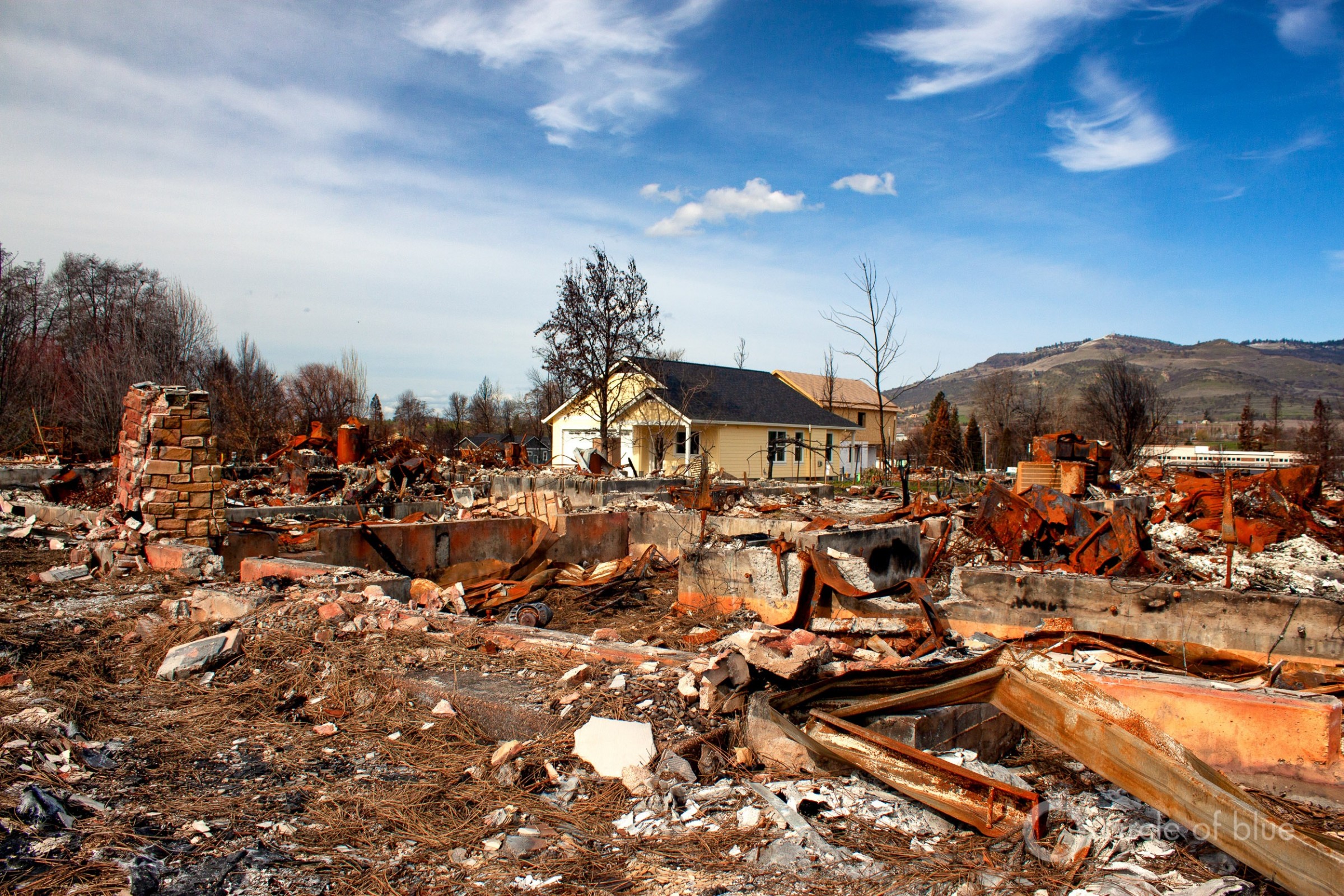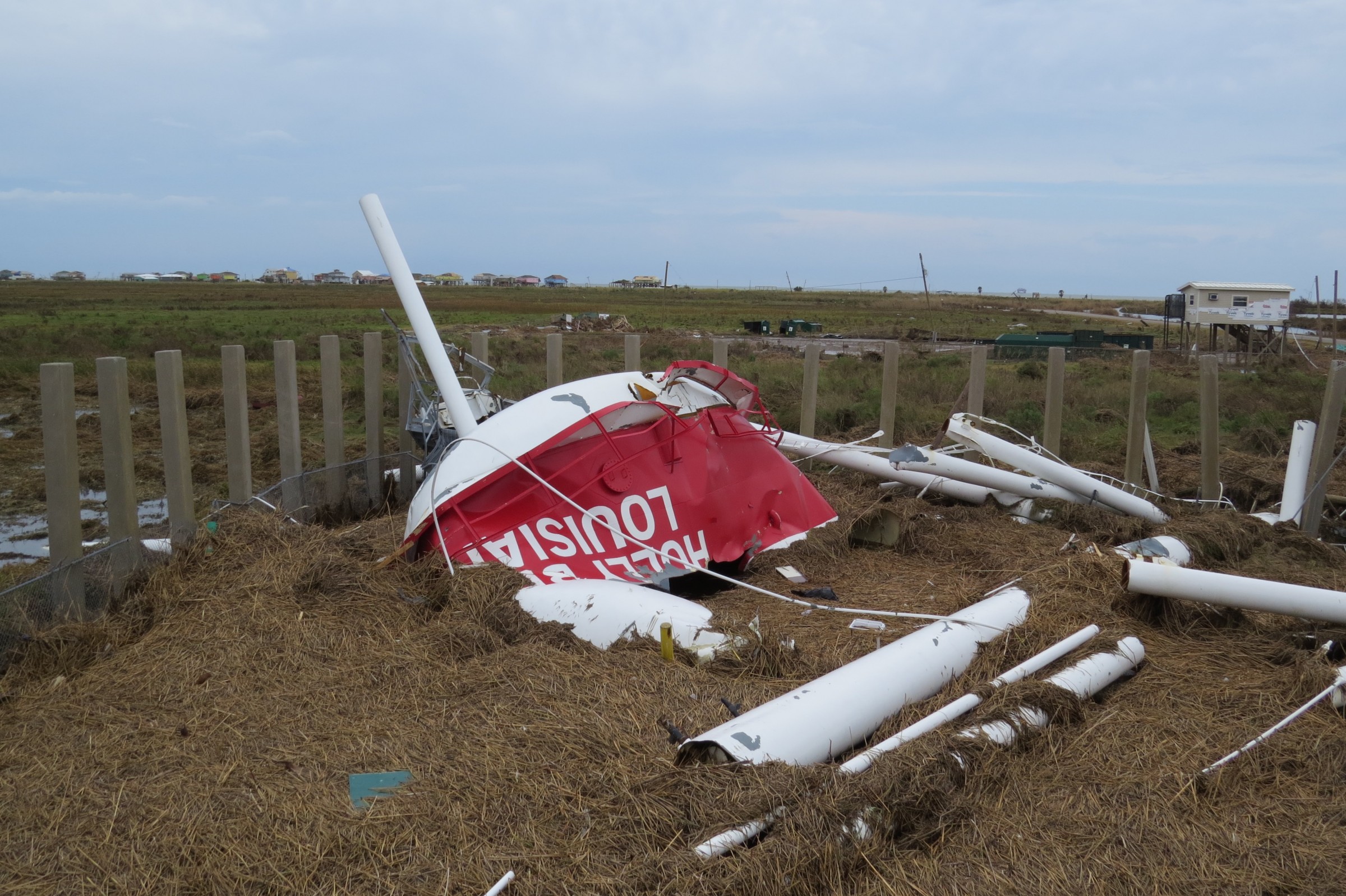Fires, droughts, floods, power outages. The interval between disasters is shortening, or in some cases disappearing altogether.

New homes rise from the post-fire rubble in Talent, Oregon. The Alameda Fire destroyed thousands of homes in Talent and nearby Phoenix in early September 2020. Photo © Brett Walton / Circle of Blue
- The interval between emergencies is shortening, or in some cases disappearing altogether.
- As disasters pile up, researchers have utilized the term “compounding” or “cascading” disasters. These are disasters that build upon one another, their effects rippling across society.
- Undermining the recovery effort is the fact that people keep putting themselves in harm’s way. Homes built in floodplains, along coasts, and in flammable forests increase exposure to hazards at the same time that a warming climate is amplifying their intensity.
By Brett Walton, Circle of Blue — July 6, 2021
The conversation had just turned in a new direction, to a discussion of the challenges government agencies face when responding to drought, when Ken Austin apologized for being temporarily — and forgivably — distracted.
“Would you ask that question again?” said Austin, the emergency services manager in Fresno County, California. “I’m getting a request about a fire that’s going on and I missed it.”
Distractions, especially this time of year, are part of the job for emergency managers like Austin. Calamitous fires in California or other western states can erupt at any moment when the vegetation is so dry. Even regions farther north are baking. On June 30, the town of Lytton, British Columbia, was ambushed by flames after the temperature soared to 121 degrees Fahrenheit. It was the capstone to a merciless week in which Lytton broke Canada’s national high-temperature record on three consecutive days. Nearly the entire town was destroyed in the fire.
The problem for Austin and his colleagues is that the interval between emergencies is shortening, or in some cases disappearing altogether. It’s not just one fire. It’s several — at the same time. Or, it’s a fire and power shutoffs happening during a drought in a region that still hasn’t recovered from the last dry cycle.
The acceleration of disaster is repeating worldwide, in part because vulnerable people and developments are encroaching on hazardous terrain. Landslides in the unstable Himalaya mountains in recent years have demolished newly built hydropower stations and killed hundreds, including more than 200 dead or missing in February from the Chamoli disaster. But the acceleration is also occurring because a supercharged climate is churning up more powerful hurricanes, more punishing droughts, more oppressive heat waves — altogether more environmental and water-related risk.
António Guterres, the United Nations secretary general, emphasized that point last week at a special UN session on water and disasters.
“Last year, cyclones lashed the shores of many countries that were already grappling with serious liquidity crises and debt burdens, made worse by the Covid-19 pandemic,” Guterres said.
The scenario that Guterres described — cyclone plus debt plus pandemic — is an example of what researchers call “compounding” or “cascading” disasters. These are disasters that build upon one another, their effects rippling across society. Any hazard has the potential to compound, but according to Susan Cutter the danger is especially acute in a society whose physical systems are so expansive and interdependent: from corporate supply chains that cross national borders to water utilities and hospitals that rely on a steady supply of power from the public grid.
“The more complexity you have in a system — unless there are tremendous redundancies, which isn’t always the case with water — you will have secondary and tertiary effects,” said Cutter, who is the director of the Hazards and Vulnerability Research Institute at the University of South Carolina. Those secondary effects can be devastating. If a utility doesn’t have sufficient generators when the power goes out — or if those generators are flooded or if fuel isn’t able to reach them, as was the case during Hurricane Sandy, in New York and New Jersey — then raw sewage spills into waterways.
Flooding from Hurricane Harvey, in 2017, resulted in power outages at the Arkema chemical facility in Crosby, Texas. Without power, the refrigeration system failed, causing the organic peroxide stored on site to explode. Residents living 1.5 miles around the site could not return home for a week and 21 people sought medical care for inhaling the fumes.
Alessandra Jerolleman, an assistant professor of emergency management at Jacksonville State University, said one of the strengths of the U.S. emergency management system is the tradition of sharing resources, both within and outside of formal disaster declarations. For water and wastewater utilities, state and regional networks called WARNs dispatch operators and work crews to areas hit by hurricanes, fires, earthquakes, or tornadoes. The crews help to repair pipes and restart the flow of drinking water. Fire crews also move across county and state lines.
But even the durable bonds of the mutual aid system can break down, Jerolleman said. “It works really well when you have some percentage in the nation having disaster impacts and some percentage not. But when everybody’s impacted, that becomes a lot harder.”
In those conditions, a series of disasters prevents people from regaining their footing. Jerolleman brought up southwestern Louisiana, which endured a year of catastrophe. Residents of Lake Charles and Calcasieu Parish were hit by Hurricane Laura in August 2020 and, six weeks later, by Hurricane Delta. Dozens of drinking water systems went offline for weeks after the first storm and essential infrastructure was destroyed. Then last winter an ice storm swept through the area, causing water and power outages that extended from Texas through Mississippi. And in May, parts of Calcasieu Parish were flooded once again after receiving more than 20 inches of rain.

Hurricane Laura, which made landfall on August 27, 2020, toppled the 100,000-gallon water tower in Holly Beach, Louisiana. Photo courtesy of Cameron Parish Waterworks District 10
Dick Gremillion, the director of the Calcasieu Parish Office of Homeland Security and Emergency Preparedness, witnessed the unprecedented damage first hand.
“It’s like everything we’ve had in the past year is the worst of that thing,” Gremillion told Circle of Blue.
The goal for emergency response is not to be overstretched. But that’s exactly how Gremillion said the people of Calcasieu Parish feel. Already there have been five named tropical storms in the Atlantic. “We’re not finished repairing our damage from last time and here it is hurricane season again,” he said.
Gremillion called it “hurricane fatigue.” People are not prepared for the emotional stress of another storm season. Nor are they physically prepared. Houses don’t have secure roofs. Buildings are not as stabilized against wind and water as they could be. According to FEMA, at the beginning of July there were 2,133 households in the parish living in temporary housing units.
“We are creating risk even faster than we can mitigate it. Even if we didn’t have climate as a compounding factor.” — Alessandra Jerolleman, an assistant professor of emergency management at Jacksonville State University Share on XThese problems were foreseen. Cutter was the chair of a 2012 National Academies of Sciences, Engineering, and Medicine report on disaster resilience. That report concluded that the work to make the nation’s physical and social networks more adaptable needed to begin now. Nine years after that “now” moment, Cutter said that actions to achieve resilience have been uneven.
For Jerolleman, the events in Calcasieu are a warning that the emergency response profession may need to rethink its operating model, engaging with individuals but not leaving them entirely on their own to cope with the proliferation of constant, compounding hazards. “We may have some expectation of some level of preparedness for the initial event, but when you’ve had so many back-to-back events, at some point there’s no way that doesn’t overwhelm individual capacity,” Jerolleman said.
Also undermining the effort is the fact that people keep putting themselves in harm’s way. Homes built in floodplains, along coasts, and in flammable forests increase exposure to hazards at the same time that a warming climate is amplifying their intensity.
“We are creating risk even faster than we can mitigate it,” Jerolleman said. “Even if we didn’t have climate as a compounding factor.”
Brett writes about agriculture, energy, infrastructure, and the politics and economics of water in the United States. He also writes the Federal Water Tap, Circle of Blue’s weekly digest of U.S. government water news. He is the winner of two Society of Environmental Journalists reporting awards, one of the top honors in American environmental journalism: first place for explanatory reporting for a series on septic system pollution in the United States(2016) and third place for beat reporting in a small market (2014). He received the Sierra Club’s Distinguished Service Award in 2018. Brett lives in Seattle, where he hikes the mountains and bakes pies. Contact Brett Walton



